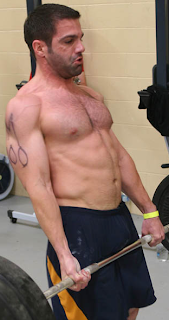Elegance is for tailors. Often attributed to Einstein, physicist Ludwig Boltzmann actually said those words. Einstein did say, "A scientific theory should be as simple as possible, but no simpler." It's an open question which is more elegant.
 |
| Albert Einstein |
 |
| Ludwig Boltzmann |
Reading
Pat Sherwood
’s lovely paean to CrossFit (and Coach Greg Glassman’s)
elegance, I was struck by the mention of Blaise Pascal—a mention not surprising given his role in developing some of the most elegant (and useful) theory in mathematics.
The first time I ever came across a workout with the 21-15-9 structure, I thought of Pascal’s arithmetical triangle.
 |
| Pascal's Arithmetical Triangle |
Looks like Greg Glassman is a genius.
But, I wondered when I saw the workout, why not 10 instead of 9?
Because the human brain needs a finish line. And with workouts only slightly less harrowing than
this experience, I understood. 70 reps into ‘Fran’, 9 looks a lot better than 10, for reasons Sherwood nicely articulates.
 |
| Coach Greg Glassman |
 |
| Pat Sherwood |





I always thought 21-15-9 was:
ReplyDelete3 * 7
3 * 5
3 * 3
I always thought that if there were one more round it would be 3 (3 * 1).
Wes,
ReplyDeleteYes. I, unfortunately, need to break up many workouts that way. Also unfortunate is that Pascal, at least, wouldn't let us off so easy: 6 (not 3) is the next number produced by his arithmetical triangle.
But, it could be worse: if someone like Rich Froning instead of Greg Glassman had invented CrossFit, he might have used the fifth row and not the third. So, our benchmark workouts would be 126-70-35!
In fact, it could be even worse than that: this kind of number series led Pascal to contemplate (at least) two kinds of infinities. Because this formula runs on endlessly (one can apply the formula and generate another and another number, "Et ainisi a l'infini". And this presaged Pascal's faith: knowing there iexists an infinite being, but being unable to grasp its unlimited nature. And so we get Pascal's wager.